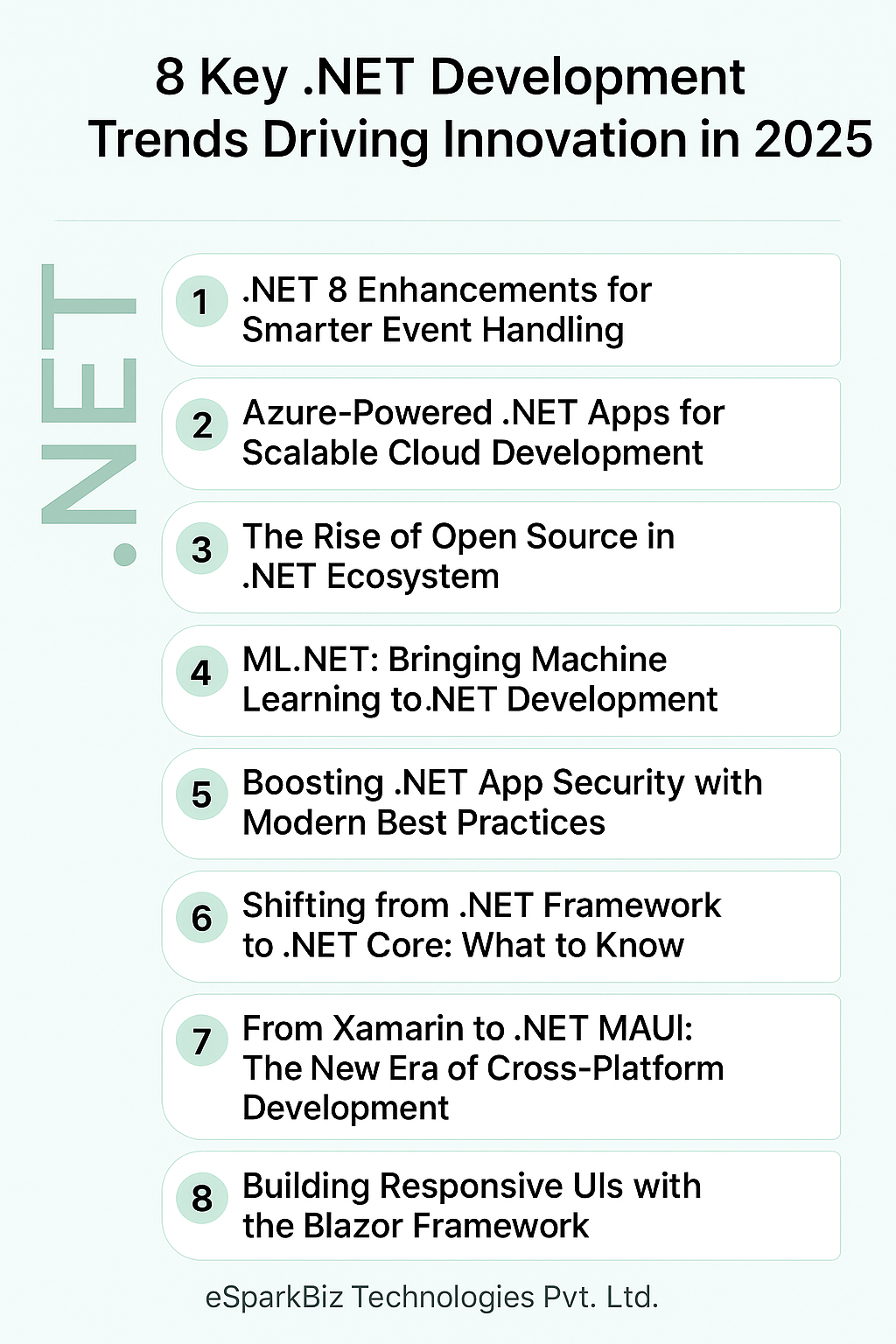Quick Summary :- .NET’s still a go-to for many developers in 2025. It’s reliable, runs on different platforms without much hassle, and scales pretty well. This year, the big .NET development trends focus on making cross-platform work smoother, cloud integration easier, and apps run faster. Microsoft backing helps, but honestly, it’s the dev community keeping things fresh sharing tips, tools, and fixes all the time. If you work with .NET, keeping up with these trends isn’t just smart, it’s necessary. In this post, we’ll cover what really matters for .NET this year.
In 2025, .NET remains a dominant force in software development ,back in 2024, nearly a One-fourth of developers worldwide about 25.2% were working with the .NET (5+) framework. It wasn’t just about popularity. The release of .NET 9 on November 12 brought along real-world upgrades: lighter memory use, smarter algorithms, and a noticeable leap in AI features. These changes didn’t just add extra features they made .NET faster, safer, and more aligned with what modern development actually demands.
A major part of .NET’s edge comes from how naturally it pairs with Microsoft Azure. That connection gives developers room to build cloud-native apps that grow as needed, without extra hassle. With support for over 60 programming languages and a mature toolset behind it, .NET lets teams move quicker without cutting corners. Combine that with regular updates and a community that actually shows up, and it’s clear why so many enterprises still lean on it to keep pace with the evolving tech world.
8 Key .NET Development Trends Driving Innovation in 2025
These 8 .NET development trends are set to shape how modern applications are built and scaled in 2025. Staying updated is key to maintaining a competitive edge.
1) .NET 8 Enhancements for Smarter Event Handling
.NET 8 is the biggest and best .NET yet in 2025 – performance, memory and developer experience. With LTS (Long-Term Support) .NET 8 gives you long term stability and new features for modern application scaling.
Key features in .NET 8:
- Native AOT (Ahead-of-Time) Compilation for super fast startup and smaller memory footprint.
- Built in metrics and logging for distributed systems.
- Simplified event handling patterns and low level improvements for cleaner codebases.
- Container support out of the box – perfect for microservice architectures and cloud native development.
Why it matters: .NET 8 isn’t just a version – it’s a production ready, performance focused toolset for teams building high speed, cross platform, scalable apps.
Example:
A patient management platform streamlines health record updates using efficient event handling patterns, ensuring smooth data flow between user actions and backend processes ideal for high-load environments.
2) Azure-Powered .NET Apps for Scalable Cloud Development
In 2025, Azure is still the foundation of .NET development, allowing you to build robust, high-performance applications at scale. As demand for cloud-native solutions grows, .NET on Azure is the go-to strategy for modern development teams.
- Azure has a full suite of tools including VMs, Kubernetes, serverless, and managed databases all .NET native.
- Seamless CI/CD helps you deploy, update and reduce operational overhead.
- Built-in global scalability, enterprise-grade security and hybrid support means you can build production ready systems faster.
Why it matters: .NET on Azure means faster delivery cycles, scalable architecture and cost effective infrastructure for organisations going cloud first.
3) The Rise of Open Source in .NET Ecosystem
Open source is the foundation of .NET in 2025, speeding up collaboration, flexibility and innovation. Since Microsoft open sourced .NET with .NET Core, the platform has grown a global community of developers.
- Developers can contribute to and benefit from a rich open source libraries, tools and frameworks for .NET.
- Open sourcing has made .NET cross platform, so it works on Windows, macOS and Linux with the same performance.
- Community driven and real-time updates means development is agile, secure and future proof.
Why it matters: Open source lets .NET teams build faster, solve complex problems together and keep up with modern software delivery.
4) ML.NET: Bringing Machine Learning to .NET Development
ML.NET is still a game-changer for .NET developers looking to build intelligent, data-driven applications in 2025. It allows teams to add ML features without leaving the .NET world, making AI more accessible across industries like finance, healthcare and logistics.
Why ML.NET is trending in 2025?
- No Python required – Train and deploy ML models using just C# or F#
- Built-in Model Builder & AutoML – Rapid prototyping for developers with no ML background
- Supports TensorFlow, ONNX and other ML runtimes
- Seamless deployment within .NET apps – From web to desktop to cloud
Why it matters: ML.NET removes the barrier to entry for machine learning inside the .NET world. With minimal overhead devs can embed predictions, sentiment analysis or recommendation systems into their apps without the need for expensive ML specialists.
5) Boosting .NET App Security with Modern Best Practices
Security isn’t optional in 2025, it’s strategic. As cyber threats evolve, .NET developers are hardening apps, encrypting and secure coding to protect business data across platforms.
Top security priorities:
- Built-in tools like DataProtection, ASP.NET Identity, and role-based authorization
- Modern cryptographic APIs for encryption
- Built-in encryption
- Secure by default: input validation, HTTPS enforcement, output encoding
- Code audits and threat modeling for proactive risk management
Why it matters: Security is no longer a feature it’s the foundation. Teams that adopt modern .NET security are building apps that perform well and earn stakeholder and user trust in a high risk world.
6) Shifting from .NET Framework to .NET Core: What to Know
The .NET Framework to .NET Core migration is picking up steam in 2025 as demand for high-performance, cross-platform and cloud-native applications grows.
Why developers are moving?
- Cross-platform (Windows, macOS, Linux) for modern deployment options
- Better performance and scalability for web, microservices and API-first
- Easier containerization with Docker and Kubernetes integration
- Faster development with lightweight runtimes and modular components
Why it matters: .NET Core isn’t just a technical upgrade it’s a strategic jump. Businesses and dev teams moving are getting more agility, cost savings and future cloud-native readiness.
7) From Xamarin to .NET MAUI: The New Era of Cross-Platform Development
With Microsoft ending support for Xamarin in May 2024, .NET MAUI (Multi-platform App UI) is the way to go for cross-platform development in 2025.
Why .NET MAUI is the shift?
- Build Android, iOS, macOS and Windows apps from a single codebase
- A modern UI-first development model instead of Xamarin.Forms
- Seamless .NET 8 and Visual Studio 2022+ integration
- Better performance, stability and tooling support than Xamarin
Why it matters: .NET MAUI is not just a replacement, it’s a big step forward in building native, cross-platform apps. Developers moving from Xamarin are getting more flexibility, better UI and long term Microsoft support aligned with the future of .NET.
Also Read: Expert Guide on Cost to Hire Remote .Net Developers in 2025
8) Building Responsive UIs with the Blazor Framework
Blazor is redefining how we build web apps with .NET in 2025. By running C# and .NET code in the browser via WebAssembly, it eliminates the need for JavaScript in many cases.
Why Blazor stands out?
- Client and server side development with just C#
- Code reuse across frontend and backend to speed up dev cycles
- Tightly integrated with .NET libraries, APIs and tooling
- Great for building responsive modern SPAs
Why it matters: Blazor is gaining popularity among dev teams looking for high performance, scalable web apps without relying on JavaScript. For .NET shops it’s a future proof way to streamline development and unify their tech stack.
Conclusion
The .NET world is changing with trends that are redefining how we build modern apps,speed, security, cross platform and AI. These are key for businesses that want to deliver high performing, future proof digital solutions.
Staying up to date with the latest trends is critical to stay competitive. That’s where we can help. As a .NET development company we help businesses adapt to the latest technologies and build solutions that meet evolving market needs.
By following these .NET development trends businesses can be more agile, better user experience and future proof for the long term.
Power Your Next .NET Project with eSparkBiz Expertise
Selecting the right technology partner is key to staying ahead in a fast changing world. At eSparkBiz, we have deep expertise in the .NET space and help businesses leverage the latest .NET trends from cross platform applications and AI-powered logic to secure, cloud native architecture.
Our .NET developers specialise in building scalable, high performing solutions that meet current industry needs. Whether you are building responsive web platforms, integrating ML capabilities or modernising legacy systems, we ensure a frictionless development process with maximum ROI.
Why wait? Get in touch today and talk to the team about your next .NET project – we’ll help you stay current, competitive and future proof.
-
Is .NET good for startups and enterprises?
Yes, .NET is good for both. Startups love its open-source flexibility and low overhead, while enterprises value its built-in security, performance and scalability all without high licensing costs.
-
What are the benefits of .NET for software development?
.NET is fast, secure and scalable across web, mobile, cloud and IoT. It supports cross-platform builds, has powerful libraries and integrates tightly with Microsoft tools like Visual Studio and Azure.
-
What are the .NET trends in 2025?
Some of the top trends shaping the .NET landscape in 2025 are:
- .NET 8 for smarter memory handling and performance
- Migrating from Xamarin to .NET MAUI for cross-platform mobile
- Blazor for modern UIs with WebAssembly support
- AI & ML with ML.NET
- Cloud-first with Azure + .NET
-
Why are businesses moving from .NET Framework to .NET Core?
This is driven by performance, portability and cloud-native compatibility.
Key reasons are:- Cross-platform (Windows, macOS, Linux)
- Lightweight and modular runtime
- Better performance and scalability
- Easier deployment with containerization
- Long term support from Microsoft
-
What to look for when hiring a .NET company?
Choosing the right tech partner is key to long term success. Here’s what to look for:
- Portfolio with modern .NET apps
- Experience in .NET Core, MAUI and Blazor
- Knowledge of Azure Cloud and CI/CD
- Post-deployment support
- Agile methodology and transparent communication




